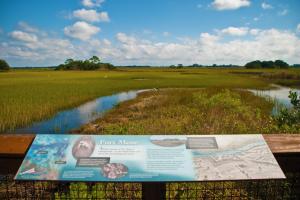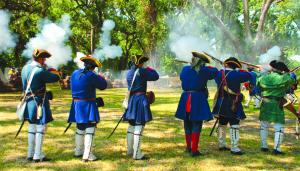
Telling the Incredible Story of America’s First Free Black Settlement

Rendering of reproduction of Gracia Real de Santa Teresa de Mose, Fort Mose, set to break gorund in January 2024.
Fort Mose offers a unique look into the lives of freed slaves with plans to build a reconstruction of the settlement.
ST. AUGUSTINE, FL, USA, August 24, 2023/EINPresswire.com/ -- St. Augustine, Ponte Vedra, and The Beaches are a goldmine of interesting and groundbreaking history – it comes with the territory when you’re known as Florida's Historic Coast. Visitors can easily identify the European influence; they most likely know the city’s Spanish history and its place in the Civil Rights Act. However, the city of St. Augustine has an even more captivating and inspiring history ensconced in its northern border – the first legally sanctioned free Black community in North America, Fort Mose.
Traveling south on US-1 from Jacksonville, just before the two statues of conquistadors standing guard is a road leading east into what looks like a residential neighborhood. Travel towards the Intracoastal Waterway and enter one of Florida’s most significant cultural resources. The settlement of Garcia Real de Santa Theresa de Mose, now referred to as Fort Mose Historic State Park, was established in 1738 as the first legally sanctioned free Black settlement in the United States. Fort Mose's inhabitants were mainly slaves of West African origin who escaped from the British colonies of South Carolina and Georgia to Spanish Florida in small groups. The first group arrived in 1687, comprised of eight men, two women, and a nursing child, traveling by dugout canoe. Along their perilous journey to St. Augustine, escaped slaves were often aided by Native Americans, creating an early Underground Railroad that ran south.
By 1738, more than one hundred brave men, women, and children had journeyed through swamps and dense tropical forests to Fort Mose. The Spanish government officially designated the settlement as Gracia Real de Santa Teresa de Mose , establishing it as a community guarding the northern boundary of St. Augustine. The Spanish crown made two provisions for Fort Mose’s residents – they needed to become loyal Spanish subjects and convert to Catholicism. Since the thirteenth century, Spanish law made freedom a possibility for slaves – they were allowed rights and protections, including the right to own property, freedom of religion, the right to judicial representation, and a strict prohibition against separating family members.
The historic Fort Mose site was discovered in 1986 during an archaeological dig led by Dr. Kathleen Deagan, a Professor of Anthropology at the University of Florida’s Florida Museum of Natural History. The property was sold to the State of Florida in 1989, and was nationally acknowledged in 1994 as a U.S. Historic Landmark. It is a key stop on the Florida African American Heritage Trail and a Site of Memory of the UNESCO Slave Route Project. In 2009, the National Park Service named Fort Mose a precursor site on the National Underground Railroad Network to Freedom.
Today, Fort Mose Historic State Park is a historical and cultural destination managed by the Florida State Parks Service. In addition to a museum and visitor center, the 41-acre park also offers opportunities for kayaking and canoeing, wildlife viewing, and picnicking. Guests can visit the settlement site, but the original earth and wooden structures that sheltered its inhabitants are gone, lost to the ravages of time. For now, at least.
The Fort Mose Reconstruction Project culminates years of planning. The Fort Mose Historical Society set a goal to reconstruct a representation of Fort Mose in the mid-1990s. The recently gained momentum when the Foundation earned a competitive grant of $933,500 from the Florida African American Cultural and Historical Grants Program to aid in construction costs. The Foundation also secured $250,000 in matching funds from Florida State Parks, the Jacksonville Jaguars Foundation, Florida Blue, The Community Foundation for Northeast Florida, and St. Johns County. The group continues its fundraising mission and still needs $500,000 in funding. A groundbreaking is planned for January 19, 2024.
“The impact of this project cannot be overstated,” says Susan Phillips, President and Chief Executive Officer for St. Augustine, Ponte Vedra, and The Beaches Visitors and Convention Bureau. “Fort Mose is a critical piece of African-American history. It should be as iconic as the Castillo de San Marcos or the St. Augustine Lighthouse. It is a beautiful place, but that final historical piece is missing. The VCB is dedicated to sharing the story of Fort Mose and doing what we can to move this project forward.”
The reconstruction of this site will breathe fresh air into Fort Mose, providing rangers, visitors, and educators with new interpretive resources for a whole new way to experience and share one of our nation’s most inspiring stories. Fort Mose already offers many activities honoring its history, including a monthly Militia Muster, where guests can experience a free musket firing demonstration from historically-authentic reenactors. Every June, a coalition of free Black Fort Mose militia, Spanish militia, and Native American allies fight the British and Scottish invaders at the Battle of Bloody Mose. This is a reenactment of an actual battle that took place on June 26, 1740, during General Oglethorpe’s invasion of Spanish Florida.
The Discover Fort Most Jazz and Blues Series is a confluence of history, community, and music. Spread over two weekends in February, the music series offers six exceptional performances and features big-name performers like Gladys Knight, Mavis Staples, The Count Basie Orchestra, Greg Porter, and Trombone Shorty & Orleans Avenue. Stay tuned for the 2024 line-up! Proceeds from the Discover Fort Mose Jazz & Blues Series support the reconstruction effort. Once the reconstruction is complete, more educational, historical, and cultural events will be possible.
Fort Mose represents the struggle and triumph of a small and mighty group of people. Be sure to visit this amazing place the next time you book your vacation or staycation to Florida’s Historic Coast.
Accompanying images are available on request:
Located midway between Daytona Beach and Jacksonville, Florida’s Historic Coast includes historic St. Augustine, the outstanding golf and seaside elegance of Ponte Vedra Beach, and 42 miles of pristine Atlantic beaches. For more information, call 1.800.653.2489 or go to the Visitors and Convention Bureau website at www.FloridasHistoricCoast.com and www.viajaStAugustine.com.
Barbara Golden
St. Augustine, Ponte Vedra & The Beaches VCB
+1 904-669-8142
email us here
Visit us on social media:
Facebook
Twitter
Instagram
YouTube
TikTok
Watering Our Roots: Fort MOse and the Underground Railroad
Distribution channels: Culture, Society & Lifestyle, Education, Human Rights, Travel & Tourism Industry, World & Regional
Legal Disclaimer:
EIN Presswire provides this news content "as is" without warranty of any kind. We do not accept any responsibility or liability for the accuracy, content, images, videos, licenses, completeness, legality, or reliability of the information contained in this article. If you have any complaints or copyright issues related to this article, kindly contact the author above.
Submit your press release

